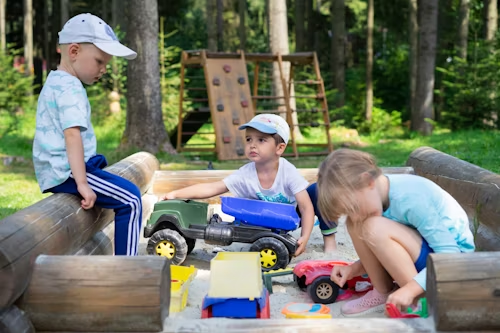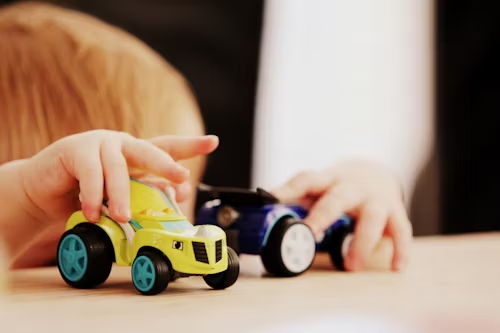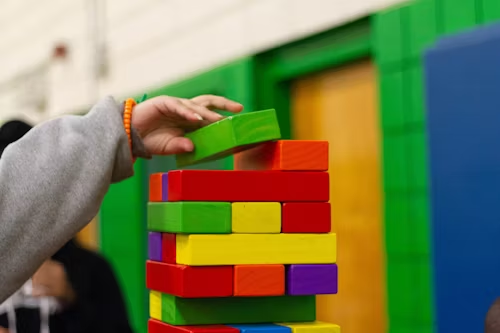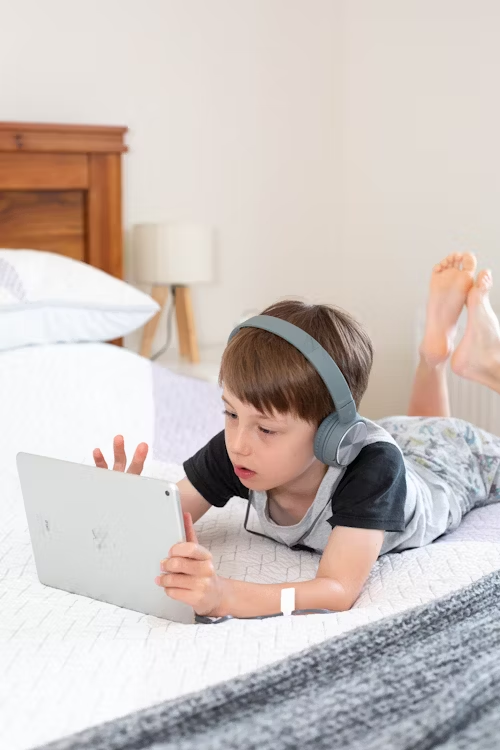
Have you ever observed the intense focus on a child’s face as they attempt to fit a square block into a corresponding hole or catch a ball in mid-air? It becomes evident that playtime transcends mere amusement; it’s a vital aspect of childhood development. Indeed, toys serve as the essential tools of this trade, facilitating growth and learning in various domains. Here is an age-specific guide to children’s play, illustrating how it evolves and toys’ crucial role in this process. From fostering understanding of the world to nurturing social and emotional skills and stimulating cognitive development, toys aid in shaping a child’s journey of discovery and growth.
Age-Specific Toy Guide: 2024’s Essential Tools to Kid’s Fun!
During their first year, babies’ play revolves around exploration and sensory discovery. Infants use their five senses to engage with the intriguing world, discerning textures, tastes, and sounds. Much of their play involves tactile exploration, with objects mouthed, shaken, banged, or dropped as they investigate their properties and reactions.
Babies and How They Play
As babies develop new motor skills, their play becomes more refined and coordinated. Around four months of age, they start reaching for and grasping objects, such as rattles. They can transfer these objects between hands for six to seven months, showcasing improved dexterity. Around nine months, the emergence of the pincer grasp facilitates the manipulation of smaller items, like blocks and age-appropriate toys. Although play tends to be solitary during this period, babies may engage in parallel play and imitation by the end of their first year.
Caregivers are pivotal play partners for infants, facilitating early social interactions and language development. Simple games, like playing with puppets or engaging in playful interactions, contribute to babies’ understanding of cause-and-effect relationships and social dynamics. As babies become more attuned to their environment and sensory experiences, they transition to the next stage of development, where they explore the mechanics of objects and how they function.

Smart toys designed for babies offer valuable opportunities for learning and development:
Nursery Mobile:
Suspended objects above a baby’s crib provide visual stimulation and promote attention span development. As babies gaze at moving objects, they engage their visual senses and begin to track movement, laying the foundation for visual perception skills.
Mirror:
Initially, babies are captivated by the changing images reflected in the mirror. Over time, they recognize their reflection, leading to self-awareness and exploration of body parts. Mirrors facilitate self-discovery and cognitive development as babies learn to identify themselves and understand spatial concepts.
Ring Stack:
This timeless toy consists of differently-sized coloured rings that fit onto a central cone. Initially, babies enjoy grasping and exploring the rings, enhancing their tactile and sensory experiences. Their fine motor skills progress as they mature by stacking the rings onto the cone while learning about colours and numbers through interactive play.
Push-Pull Toys:
These toys aid in balance and large-muscle development as babies transition from crawling to walking. Babies strengthen their muscles and improve coordination by pushing and pulling these toys. As toddlers, they refine their motor skills and learn to control their speed, laying the groundwork for physical confidence and agility.
Toddlers and How They Play
Toddlers are at a crucial stage of development, where they begin to comprehend the functionality of objects. Engaging in activities like stacking blocks, babbling into toy phones, or mimicking daily routines with pretend play, they explore the world around them while laying the foundation for imaginative thinking. Through simple acts like tucking a baby doll into bed or making sound effects while playing with toy trains, toddlers immerse themselves in imaginative scenarios that reflect their growing understanding of the world.
As toddlers transition into preschool play, their grasp of object functionality becomes more refined. Activities such as operating the oven timer in a play kitchen or sounding the bell on a pretend fire truck signify their evolving comprehension of the purposes served by various items. Additionally, toddlers begin to identify colours and shapes, prompting caregivers to select vibrant, colourful, and tactilely engaging toys to facilitate their cognitive development and sensory exploration.
By age 2, most toddlers demonstrate basic motor skills such as kicking a ball, scribbling with crayons, and building towers with blocks. By age 3, they progress to more complex tasks like solving simple puzzles and pedalling a tricycle. Repetition plays a crucial role in their learning journey, as toddlers engage in repetitive actions to master new skills and assert their growing sense of control over their environment. Through play, toddlers embark on a journey of discovery, gradually uncovering the intricacies of the world and their capabilities within it.
Smart toys tailored for toddlers offer a plethora of benefits for their cognitive and physical development:
Balls:
Versatile and engaging, balls provide opportunities for toddlers to enhance their gross motor skills, hand-eye coordination, and agility. Whether bouncing, rolling, catching, or throwing, toddlers engage in dynamic play that promotes physical activity and spatial awareness.
Shape-Sorting Toys:
These toys, including pegboard puzzles, nesting cups or blocks, and buckets with holes for different shaped blocks, challenge toddlers’ hand-eye coordination and problem-solving skills. Toddlers refine their fine motor and spatial reasoning abilities as they manipulate the various shapes and attempt to fit them into corresponding slots.
Mechanical Toys:
Pop-up toys and “busy” boxes equipped with knobs, buttons, and levers provide opportunities for toddlers to develop fine motor skills and problem-solving abilities. By interacting with these toys, toddlers learn about cause-and-effect relationships and better comprehend how mechanical systems function.
Role-Play Toys:
Play kitchens, doctor’s kits, and golf sets allow toddlers to imitate the actions of influential adults, promoting understanding of the world around them. Dolls and stuffed animals encourage pretend play, fostering social and emotional development as toddlers learn to express emotions and care for their beloved toys. Through role-play, toddlers enhance their creativity, empathy, and communication skills, laying the groundwork for meaningful interactions and emotional intelligence.
Preschoolers and How They Play
As preschoolers transition from the exploratory stages of infancy and the imaginative play of toddlerhood, they begin to navigate a world brimming with endless possibilities. Toys and everyday objects take on multifaceted roles, serving their intended purposes and igniting imaginative adventures. A simple blanket draped over a coffee table transforms into a secret clubhouse. Modelling clay becomes the medium for crafting culinary delights and fantastical creations, inviting exploration and interaction.
For preschoolers, the world becomes a canvas for boundless creativity and exploration, where they wield the power to shape their realities. With burgeoning imaginations, they embrace roles as superheroes, royalty, or mystical creatures, engaging in elaborate fantasy play that reflects their evolving understanding of the world and their place within it. Preschoolers grapple with their fears, hopes, and aspirations as they immerse themselves in make-believe worlds, using imaginative play for emotional expression and growth.
Additionally, preschoolers eagerly seek opportunities for social connection and validation, showcasing their newfound skills and seeking approval from caregivers and peers alike. Cooperative play and sharing become essential to their interactions as they navigate friendship and social reciprocity dynamics. With a deeper understanding of the world around them, preschoolers exhibit a natural curiosity and desire for exploration, demonstrating physical prowess through dynamic movement and playful experimentation with their environment.

Smart toys designed for preschoolers offer a wealth of developmental benefits:
Arts and Crafts:
As acceptable motor skills progress, engaging in activities like drawing with crayons, crafting pictures of family members, and using safety scissors to cut and paste not only enhances coordination but also fosters creativity and boosts self-esteem. Preschoolers explore their imagination through artistic expression and develop a sense of pride in their creations.
Blocks and Construction Sets:
Building with blocks and construction sets challenges preschoolers’ problem-solving skills and hand-eye coordination. Whether they’re constructing towers, vehicles, or animals, preschoolers engage in imaginative play that encourages spatial reasoning and creative thinking. They learn about balance, stability, and cause-and-effect relationships by experimenting with different configurations.
Puzzles:
Jigsaw puzzles provide opportunities for preschoolers to refine their coordination, talent, and cognitive skills. By piecing together puzzles, they understand spatial relationships and logical thinking. Preschoolers sharpen their problem-solving abilities as they tackle increasingly complex puzzles and gain satisfaction from completing challenging tasks.
Elementary School-Age Children and How They Play
As elementary school-age children grow and develop, they demonstrate mastery in various aspects of their lives. Armed with a deeper understanding of the world, they embark on a journey toward mastering skills that once posed challenges, such as catching a football or braiding a friend’s hair. This period marks the emergence of individual talents and interests as children gravitate towards activities that ignite their passion and curiosity. A love for reading, music, or other hobbies begins to flourish, laying the groundwork for lifelong pursuits.
Physical development plays a significant role during this stage, with children refining their large and fine motor skills. From riding two-wheel bicycles to mastering skateboards, they embrace new challenges and hone their abilities. Creative endeavours become more intricate as children delve into arts and crafts, spending hours weaving friendship bracelets or crafting elaborate comic strips. As they immerse themselves in these activities, they gain a sense of accomplishment and pride in their creations.
Peer relationships assume greater significance during this period as children become more invested in interacting with classmates and peers. While social dynamics shift, parents remain crucial playmates and sources of support for their children. Family game nights offer opportunities for bonding and connection, fostering a sense of togetherness amid busy schedules. As children embark on new adventures, such as off-road biking, parental supervision ensures safety while encouraging exploration and growth.
Smart toys designed for big kids offer opportunities for growth and development across various domains:
Jump Rope:
Skipping rope with friends fosters social skills like turn-taking and cooperation and promotes extensive motor development and problem-solving abilities. The coordination required for jumping enhances physical fitness while encouraging children to overcome challenges and find solutions.
Card and Board Games:
Engaging in card games like “war” or “crazy eights” and board games like checkers or chess introduces children to strategy, turn-taking, and rule negotiation. These games encourage critical thinking and decision-making skills while promoting fair play and emotional regulation. Through gameplay, children learn to manage both the exhilaration of victory and the letdown of defeat, fostering resilience and sportsmanship.
Musical Instruments:
Engaging with instruments like the piano, violin, or guitar enhances listening skills, fine motor coordination, and attention span. By mastering musical techniques and understanding musical theory, children develop a deeper appreciation for rhythm, melody, and harmony, nurturing their creativity and self-expression.
Science Toys:
Exploration and discovery are encouraged through science toys like chemistry sets, binoculars, or telescopes. These toys spark curiosity and promote problem-solving skills as children engage in hands-on experimentation and observation. By delving into math and science, children expand their knowledge base and cultivate their imagination, preparing them for future academic pursuits and real-world challenges.
Conclusion:
This age-wise guide illuminates the pivotal role of play in children’s development, offering insights into the types of toys that entertain and facilitate learning and growth. From fostering social and emotional skills to stimulating cognitive development, the toys recommended in this guide serve as invaluable tools for nurturing young minds and encouraging exploration. By understanding how children play and selecting appropriate toys that align with their developmental stages, caregivers can create enriching environments that support holistic development and lay the groundwork for a bright future.





